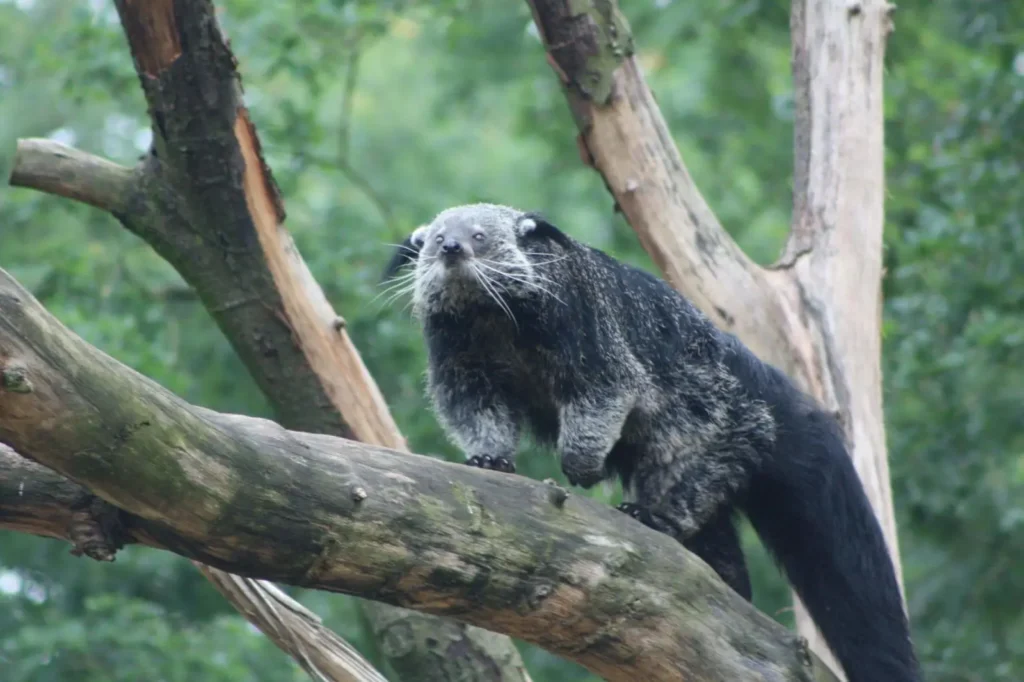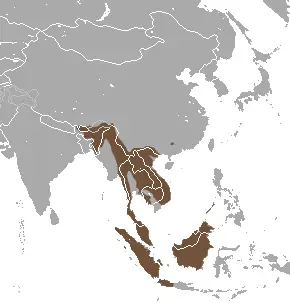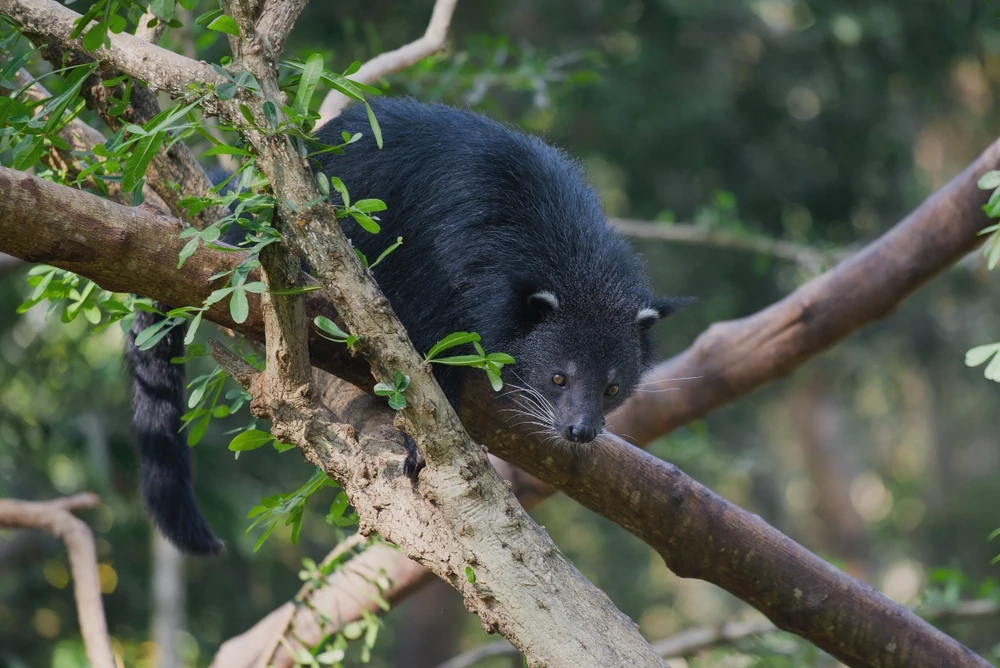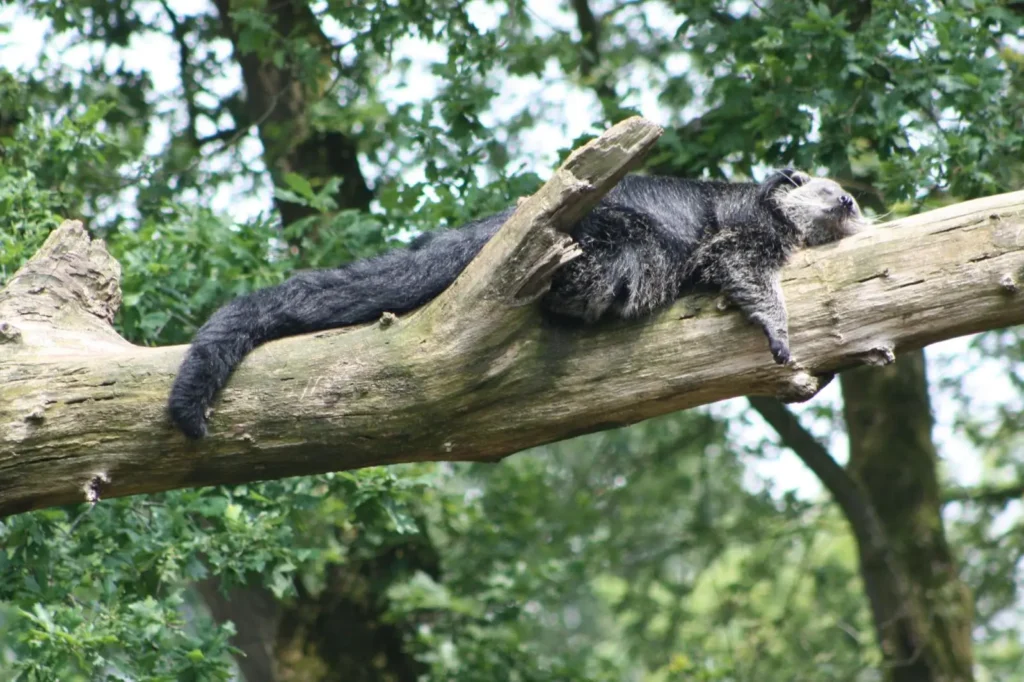Binturong (Arctictis binturong) is a large arboreal carnivore from the viver family (Viverridae), which lives in the dense tropical forests of Southeast Asia. This unusual creature resembles a bear, a cat, and a vervet at the same time, which is why it is often called "bear cat".
Binturongs are known for their thick black fur, long, clinging tail, and unusual odor, similar to buttered popcorn. They are nocturnal, live mainly in trees, and are omnivores that play an important role in the spread of tropical tree seeds.

Classification and scientific name
• The Kingdom: Animals (Animalia)
• Type: Chordal (Chordata)
• Class: Mammals (Mammalia)
• Row: Predatory animals (Carnivora)
• Family: Weaver (Viverridae)
• Gender: Binturong (Arctictis)
• View: Binturong (Arctictis binturong)
Binturong is the only representative of its genus (Arctictis) and has several subspecies inhabiting different regions of Southeast Asia.
Physical characteristics
Dimensions and weight
📌 Body length: 60-97 cm
📌 Tail length: 50-90 cm
📌 Weight: 9-20 kg (males are usually larger than females)
The binturong is one of the largest members of the viver family, second only to the Asian civet.
Color and fur
✔ The color of the coat: from dark brown to black
✔ Long and thick fur
✔ Short, strong paws with sharp claws
✔ A long, grippy tail that helps to maintain balance
The eyes of the binturong glow in the dark due to the tapetum, a reflective layer of the retina characteristic of nocturnal animals.

Range and habitat
🌍 Spread
Binturong lives in the following countries:
✔ India (Assam)
✔ Nepal
✔ Bangladesh
✔ China (southwestern regions)
✔ Myanmar
✔ Thailand
✔ Cambodia
✔ Laos
✔ Vietnam
✔ Malaysia
✔ Indonesia (Sumatra, Borneo, Java, Kalimantan, Philippines)
🌿 Living environment
✅ Dense tropical and subtropical forests
✅ Mangrove forests and bamboo thickets
✅ High mountain forests up to 1500 m above sea level
Binturongs rarely go down to the groundThey prefer to live in trees.
Lifestyle and behavior
🌙 Nocturnal predator
✅ Most active at night and at dusk
✅ Hides in hollows or among branches during the day
✅ Not very active, leads a calm and lazy lifestyle
🌳 The woody way of life
✅ Uses the tail as a "fifth leg"
✅ Easily climbs trees and jumps from branch to branch
✅ Swims well

🌟 Behavioral features
✔ It is noted curiosity and intelligence
✔ In case of danger, it can hiss and growl
✔ Smells like buttered popcorn due to the presence of certain chemical compounds in the urine
Binturong usually solitarybut sometimes forms small groups of 2-3 individuals.
Food and hunting
🥭 Omnivorous diet
Binturong is opportunistic omnivoreIt can consume both animal and plant foods.
🍎 Vegetable food:
✔ Fruits (especially dates)
✔ Berries, flowers
✔ Leaves and sprouts
🦗 Animal food:
✔ Insects, worms
Small rodents, birds, frogs
✔ Bird eggs
✔ Fish
🌿 Role in nature
Binturong plays an important environmental role because distributes seeds of tropical treesespecially figs.
Reproduction and life cycle
❤️ Mating season: no clear seasonality
❤️ Pregnancy: 90-92 days
❤️ Number of cubs: 1-3 (rarely up to 6)
❤️ Puberty: 2.5-3 years
👶 Newborn binturongs:
- Born blind and helpless
- Stay in the nest for the first 6-8 weeks
• The mother takes care of them up to 6 months
🧬 Life span:
✔ In the wild - 15-18 years old
✔ In captivity - up to 25 years old

Natural enemies and threats
🔴 Natural predators
✔ Large birds of prey
✔ Tigers
✔ Leopards
✔ Python snakes
🔴 The main threats from humans
✔ Destruction of tropical forests
✔ Hunting for fur and meat
✔ Trade in exotic animals
Protected status and rescue efforts
🟡 IUCN status: Vulnerable (VU)
🔹 The main threat is deforestation and hunting
🔹 Binturong is listed in the CITES Convention (Appendix III)
🛡 Security measures:
✔ Protection of nature reserves
✔ Restrictions on animal trade
✔ Breeding in zoos
Interesting facts about binturong
🔹 Has semi-clinging tailthat can hold a body on a branch
🔹 The smell of his urine is similar to buttered popcorn
🔹 The binturong is one of the few predatory animals that helps trees reproduce
🔹 In captivity, it can learn to interact with people and follow simple commands
Conclusion
The binturong is a mysterious, agile, and unusual animal that lives on the borderline between carnivore and frugivore. It plays an important role in maintaining rainforest ecosystems, but its population is threatened by human activity.